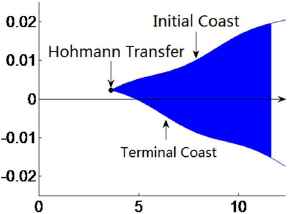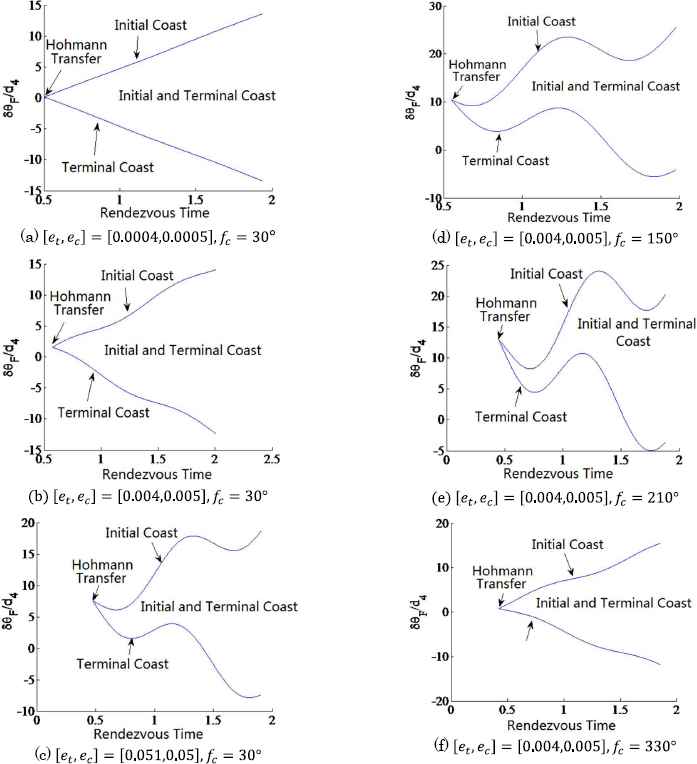Optimal Hohmann-Type Impulsive Ellipse-to-Ellipse Coplanar Rendezvous
- DOI
- 10.2991/jrnal.2018.5.1.1How to use a DOI?
- Keywords
- Optimal impulsive rendezvous; Hohmann-type rendezvous; ellipse-to-ellipse; optimal distribution
- Abstract
This paper devotes to the problem of ellipse-to-ellipse coplanar rendezvous, where the solution and distribution of Hohmann-type optimal impulsive rendezvous are investigated. The analytical relation between the initial states and rendezvous time are derived for Hohmann-type, and the optimal impulse amplitudes are given thereupon. The distribution boundary of Hohmann-type model is obtained according to the Hohmann transfer and Hohmann with coasts. Simulations are demonstrated to analyze the influences of the solution and distribution.
- Copyright
- Copyright © 2018, the Authors. Published by Atlantis Press.
- Open Access
- This is an open access article under the CC BY-NC license (http://creativecommons.org/licences/by-nc/4.0/).
1. Introduction
Optimal impulsive rendezvous is aimed at obtaining minimum-fuel guidance strategy for spacecraft rendezvous, which has attracted considerable attention. Despite that Lawden’s necessary conditions1 for optimal impulsive trajectories and Lion’s improving methods2 for non-optimal trajectories have provided some guidelines to solve the optimal problem where the initial states and rendezvous time are specified, the distributions of optimal models cannot be obtained clearly in these way. So far, only Prussing’s theory3 of optimal impulsive rendezvous on close circular orbits is complete in its theoretical system, which derives the solutions and distributions of optimal impulsive models by solving the primer vector equations and boundary value problem. A reference frame in mean velocity orbit was built by Frank4, and showed better performance in describing the impulse locations and magnitudes than the mean radius orbit in Prussing’s results. Xie5 focused on the selection of reference frame for optimal impulsive rendezvous, and investigated the effect on the classification, distribution and guidance precision. For the case of elliptic orbit rendezvous, Wang6 used the state transition matrix given by Yamanaka7 to calculate the optimal solution of four-impulse model, but the analytical solution and the distribution are difficult to be achieved. Chen8,9 studied the ellipse-to-circle coplanar rendezvous based on his results on the dynamical equations for elliptic orbit rendezvous in low eccentricity, and provided the solutions and distributions of all types optimal models. Motivated by which, our previous work10 considered the ellipse-to-ellipse coplanar rendezvous and obtained the analytical solution and distribution of four-impulse model. In this paper, we will further investigate the Hohmann-type model for optimal impulsive ellipse-to-ellipse coplanar rendezvous.
2. Dynamics Description
The relative motion between two spacecrafts in elliptic orbits was derived in our previous work10, which is still used in this paper and given as follow:
The initial and terminal states of system (1) are
The states at phase angle τ was also deduced[10]:
3. Optimal Hohmann-Type Rendezvous
The solution to primer vector equations corresponding to system (1) can be given in the following form:
3.1. Solution of Hohmann transfer
The impulse direction can be obtained from the solution (6), while the impulse time and magnitudes needed be calculated according to the following boundary value problem:
3.2. Distribution of Hohmann-type model
The distribution of optimal Hohmann-type rendezvous is to illustrate the existence of feasible solution. To investigate the distribution, rendezvous time is chosen as the X-coordinate and the special phase angle defined below as Y-coordinate:
Let τFh be rendezvous time solved by (11) and (14), and δθFh is the corresponding special phase angle. If τF = τFh and δθF = δθFh, then it is just the Hohmann transfer. The two impulses are implemented at τ1 = 0 and τ2 = τF. However, when the real rendezvous time is longer than τFh, the coasts are needed to save the fuel.
If τF > τFh and δθF = δθFh, it is a Hohmann model with terminal coast. The two impulses are implemented at τ1 = 0 and τ2 = τFh, and the residual time τF – τFh is for terminal coast. The special phase angle δθF and rendezvous time τF should satisfy the following relation
If τF > τFh and the special phase angle δθF satisfies
Let

Distribution of Hohmann-type model
From the above, the optimal Hohmann-type impulsive rendezvous has four models, all of whose impulse magnitudes are determined by (9) and (15), and impulse direction is along the tangential direction.
4. Simulations
In this section, simulation examples are presented to show the guidance performance and distribution of Hohamman-type impulsive rendezvous.
4.1. Hohmann ellipse-to-ellipse rendezvous
It is assumed the semi-major axis and eccentricities of the target orbit and chaser orbit are initially at = 6730 (km), ac = 6750 (km), et = 0.0005 and ec = 0.0004, respectively. Let τF and β (rad) be the appropriate rendezvous time and initial difference of phase angle, respectively, which satisfy (11) and (14). And denote Rr(m) as the optimal radius of reference frame, R(m) as the initial relative distance, Δa(m), Δe and Δθ(rad) as the guidance errors.
Simulation results of Hohmann transfer for ellipse-to-ellipse rendezvous are demonstrated in Table 1, which shows that: (1) with different true anomalies, even if the other initial states are the same, the rendezvous time and initial difference of phase angle which satisfy (11) and (14) varies much; (2) the optimal radius of reference frame also changes with the true anomaly; (3) the guidance precision is high when the chaser initially stays around the perigee.
| 1 | 2 | 3 | 4 | |
|---|---|---|---|---|
| fc | 30° | 150° | 210° | 330° |
| τF | 3.62 | 3.44 | 2.80 | 2.68 |
| β | 7.12e-03 | 9.68e-03 | 6.04e-03 | 3.46e-03 |
| Rr | 6.70e+06 | 7.92e+06 | 7.81e+06 | 6.71e+06 |
| R | 4.99e+04 | 7.05e+04 | 4.83e+04 | 2.71e+04 |
| Δa | 6.80e+01 | 3.38e+04 | 3.09e+04 | 2.49e+01 |
| Δe | 3.38e-05 | 4.51e-03 | 4.22e-03 | 8.92e-06 |
| Δθ | 5.82e-06 | 2.87e-04 | 3.50e-05 | 3.80e-06 |
| ΔR | 1.29e+02 | 5.14e+03 | 5.71e+02 | 5.08e+01 |
Results of Hohmann impulsive rendezvous
4.2. Distribution of Hohmann-type model
To investigate the distribution of Hohmann-type ellipse-to-ellipse rendezvous, we take rendezvous time τF as the X-coordinate and δθF/d4 as Y-coordinate. Fig. 2 shows the distribution of Hohmann-type model with different true anomalies and eccentricities.

Distributions with different true anomalies and eccentricities
5. Conclusion
This paper extends our previous work10 to the Hohmann-type optimal impulsive rendezvous. By defining the special phase angle, we derived the analytical solution for Hohmann transfer, and obtained that the optimal Hohmann-type impulsive rendezvous has four models, i.e. Hohmann transfer, Hohmann with initial coast, Hohmann with terminal coast and Hohmann with both coasts. In further research, we will integrate all optimal models in one map, including four-impulse, three-impulse, three-impulse with coasts, two- impulse, two-impulse with coasts, and Hohmann-type.
Acknowledgements
This work was supported by NSFC (61327807, 61521091, 61520106010, 61134005) and the National Basic Research Program of China (973 Program: 2012CB821200, 2012CB821201)
References
Cite this article
TY - JOUR AU - Xiwen Tian AU - Yingmin Jia PY - 2018 DA - 2018/06/30 TI - Optimal Hohmann-Type Impulsive Ellipse-to-Ellipse Coplanar Rendezvous JO - Journal of Robotics, Networking and Artificial Life SP - 1 EP - 5 VL - 5 IS - 1 SN - 2352-6386 UR - https://doi.org/10.2991/jrnal.2018.5.1.1 DO - 10.2991/jrnal.2018.5.1.1 ID - Tian2018 ER -
